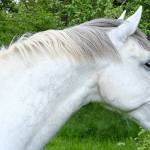Chew on This: Masticatory Muscles May Be Problematic in Horses

Mastication, or chewing, requires great muscular effort. As with other tissues in the body, masticatory muscles are susceptible to inflammation and disease.
The primary muscles that supply the power necessary to crush and grind feedstuffs are the masseter, temporalis, and pterygoids (pronounced with a silent “p,” as in tair-uh-GOYDs), both medial and lateral. The four muscles can be divided into two groups: (1) a superficial group comprising the masseter and temporalis muscles, and (2) a deep group comprising the medial and lateral pterygoids. The actions of these muscles open and close the mouth by influencing motion on the mandible or jawbone.
The largest and strongest of these muscles is the masseter, which creates the fullness of flesh that overlays the cheek of the jawbone. In some horses, this muscle is nearly two inches thick.*
Of these muscles, the masseter is the most likely site of disease or malfunction.+ Masseter myodegeneration (muscle deterioration) due to nutritional deficiency and masseter myositis (muscle inflammation) have been observed, often characterized by the inability to open the mouth, difficulty or reluctance to swallow, and excessive saliva production. Signs of chronic disease include masseter muscle atrophy and weight loss. More extensive damage, including muscle death, is often found on microscopic tissue examination.
Systemic or body-wide disorders also affect the muscles used in mastication. Spasms of these muscles may occur with hyperkalemic periodic paralysis and toxicity caused by ingestion of organophosphates. Immune-mediated conditions and neurological disease may also affect these muscles.+
In addition to a veterinary workup, consultation with an equine nutritionist to determine the adequacy of the diet is recommended. Nutritional support, including supplementation with vitamin E, may be helpful. Choose a natural-source vitamin E, such as Nano-E, that has superior bioavailability due to its mode of delivery: nanodispersion.+
Though uncommon, problems associated with the masticatory muscles occur in horses, and should be ruled out when horses have difficulty chewing and swallowing their feed. Some horses are diagnosed with temperomandicular joint syndrome, so keep that in mind if a horse has difficulty chewing.
*Bennett, D. 2022. The head. In: Horse conformation: Principles of form and function, Vol. II: The axial body: Head, neck, back and teeth. Equine Studies Institute Press. Livingston, CA.
+Aleman, M. 2023. Brief review of masseter muscle disorders. Equine Veterinary Education:13767.








